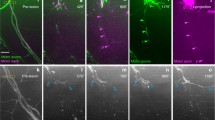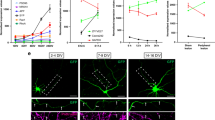Zusammenfassung
Die Elongation von Axonen und aktive Modellierung ihrer Terminale stellt die Grundlage für die Entstehung neuraler Schaltkreise während der Entwicklung dar, determiniert Erfolg oder Mißerfolg neuraler Regeneration und trägt möglicherweise zu verchiedenen Formen synaptischer Plastizität im erwachsenen Zentralnervensystem bei. Die selektive Inaktivierung oder Retention des Axonwachstums in reifenden Nervenzellen mag sodann die Grenzen für regenerative Prozesse einschließlich der synaptischen Plastizität im adulten Zentralnervensystem verursachen.
Preisträger des Ludwig-Guttmann-Preises 1994
Access this chapter
Tax calculation will be finalised at checkout
Purchases are for personal use only
Preview
Unable to display preview. Download preview PDF.
Similar content being viewed by others
Literatur
Alexander KA, Cimier BM, Meier KE, Storm DR (1987) Regulation of calmodulin binding to p57. J Biol Chem 262: 6108–6113
Basi GS, Jacobson RD, Virag J et al. (1987) Primary structure and transcription regulation of GAP-43, a protein associated with nerve growth Cell 49: 785–791
Bisby MA (1987) Dependence of GAP-43 (B50, F1) transport on axonal regeneration in rat dorsal root ganglion neurons. Brain Res: 157–161
Brodai A (1981) Neurological Anatomy. Oxford University Press, New York, Oxford
Coggins PJ, Zwiers H (1989) Evidence for a single protein kinase C–mediated phosphorylation site in rat brain B-50. J Neurochem 53: 1895–1901
Giesler GJ, Spiel HR, Willis WD (1981) Organization of spinothalamic tract axons within the rat spinal cord. J Comp Neurol 195: 245–252
Hoffman PN (1989) Expression of GAP-43, a rapidly transported growth-associated protein, and class II beta tubulin, a slowly transported cytoskeletal protein, a coordinated in regenerating neurons. J Neurosci 9: 893–897
Kalil K (1988) Regeneration of pyramidal tract axones. In: Waxman SG (ed) Advances in neurology 47: Functional recovery in neurological disease. Raven Press, New York, pp 67–85
Kalil K and Skene JHP (1986) Elevated synthesis of an axonally transported protein correlates with axon outgrowth in normal and injured pyramidal tracts. J Neurosci 6: 2563–2570
Pullen AH, Sears TA (1983) Trophism between C-type terminals and thoracic motorneurons in the cat. J Physiol 337: 373–388
Reh TA, Redshaw JD, Bisby MA (1987) Axons of the pyramidal tract do not increase their transport of growth-associated protein after axotomy. Mol Brain Res 2: 1–6
Rothshenker S, Tal M (1985) The transneuronal induction of sprouting and synapse formation in intact mouse muscles. J Physiol 360: 387–396
Ruth JL, Morgan C, Pasko A (1985) Nucleotide linker arm analogues useful in oligonucleotide synthesis. DNA 4: 93
Schnell L, Schwab ME (1990) Axonal regeneration in the rat spinal cord produced by an antibody against myelin-associated neurite growth inhibitors. Nature 343: 269–272
Skene JHP (1989) Axonal growth-associated proteins. Ann Rev Neurosci 12: 127–156
Steiner TJ, Turner LM (1972) Cytoarchitecture of the rat spinal cord. J Physiol 222: 123–125 P
Van der Zee CEEM, Nielander HB, Vos JP et al. (1989) Expression of growth-associated protein B-50 (GAP-43) in dorsal root ganglia and sciatic nerve during regenerative sprouting. J Neurosci 9: 3505–3512
Verge VMK, Tetzlaff W, Richardson PM, Bisby MA (1990) Correlation between GAP-43 and nerve growth factor receptors in rat sensory neurons. J Neurosci 10: 926–934
Wakim BT, Alexander KA, Masure HR et al. (1987) Amino acid sequence of p 57, a neurospecific calmodulin-binding protein. Biochem 26: 7466–7470
Wiese UH, Emson PC, Sheppard RC (1989) Production of C- and N-terminusspecific anti-(GAP43) antibodies. Biochem Soc Trans 17: 1058–1059
Wiese UH, Emson PC, Sheppard RC (1991) Production and characterisation of an anti-peptide antibody specific for the growth-associated protein, GAP-43. Brain Res 554: 145–152
Wiese UH, Ruth JL, Emson PC (1992) Differential expression of growth-associated protein (GAP-43) mRNS in rat primary sensory neurons after peripheral nerve lesion: a non-radioactive in situ hybridisation study. Brain Res 592: 141–156
Woolf CJ, Reynolds ML, Molander C et al. (1990) The growth-associated protein GAP-43 appears in dorsal root ganglion cells and in the dorsal horn of the rat spinal cord following peripheral nerve injury. Neuroscience, 34: 465–478
Editor information
Editors and Affiliations
Rights and permissions
Copyright information
© 1996 Springer-Verlag Berlin Heidelberg
About this paper
Cite this paper
Wiese, U.H. (1996). Expression von Growth-associated-Protein (GAP-43) als Indikator neuroregenerativer Prozesse im Rückenmark. In: Gerner, HJ. (eds) Querschnittlähmungen. Springer, Berlin, Heidelberg. https://doi.org/10.1007/978-3-642-88030-8_2
Download citation
DOI: https://doi.org/10.1007/978-3-642-88030-8_2
Publisher Name: Springer, Berlin, Heidelberg
Print ISBN: 978-3-540-60167-8
Online ISBN: 978-3-642-88030-8
eBook Packages: Springer Book Archive




